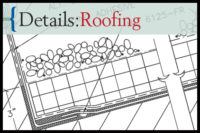Roofing Detail: Overflow Scupper Flashing
The profile of specific components, their configuration or sequencing, can vary with the roof system, climatic differences, and regional or area practices. Dimensions as shown are recommended minimums and are intended to be approximate to allow for reasonable tolerances due to field conditions. Flashing or stripping ply should extend into scupper throat, and be fully welded. Seal exterior of scupper at wall penetration.
See Appendix A for gauge or thickness guide for sheet metal flashing. Continuous cleats are recommended when flashing face dimension exceeds 3 inches and in areas deemed a high-wind zone as categorized by local building code. Note that ES-1 guidelines have been adopted by the International Building Code. (See Note 3 in Appendix A.)
For sunny, hot, and/or high altitude projects located in winter-time heating climates, WSRCA suggests that thermoplastic single-ply roof membranes and flashing ply(s) be white, or another light color, to provide a reflective surface minimizing heat gain and thermal aging. Certain components as depicted in these details may not be provided by the roofing contractor.
Looking for a reprint of this article?
From high-res PDFs to custom plaques, order your copy today!



